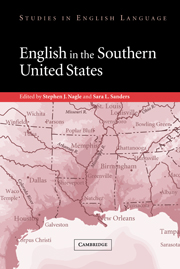Book contents
- Frontmatter
- Contents
- Notes on the contributors
- Acknowledgments
- Introduction
- 1 The origins of Southern American English
- 2 Shakespeare in the coves and hollows? Toward a history of Southern English
- 3 Eight grammatical features of southern United States speech present in early modern London prison narratives
- 4 The shared ancestry of African-American and American-White Southern Englishes: some speculations dictated by history
- 5 The complex grammatical history of African-American and white vernaculars in the South
- 6 Grammatical features of southern speech: yall, might could, and fixin to
- 7 Sounding southern: a look at the phonology of English in the South
- 8 Vowel shifting in the southern states
- 9 Enclave dialect communities in the South
- 10 Urbanization and the evolution of Southern American English
- 11 The Englishes of southern Louisiana
- 12 Features and uses of southern style
- References
- Index
8 - Vowel shifting in the southern states
Published online by Cambridge University Press: 22 September 2009
- Frontmatter
- Contents
- Notes on the contributors
- Acknowledgments
- Introduction
- 1 The origins of Southern American English
- 2 Shakespeare in the coves and hollows? Toward a history of Southern English
- 3 Eight grammatical features of southern United States speech present in early modern London prison narratives
- 4 The shared ancestry of African-American and American-White Southern Englishes: some speculations dictated by history
- 5 The complex grammatical history of African-American and white vernaculars in the South
- 6 Grammatical features of southern speech: yall, might could, and fixin to
- 7 Sounding southern: a look at the phonology of English in the South
- 8 Vowel shifting in the southern states
- 9 Enclave dialect communities in the South
- 10 Urbanization and the evolution of Southern American English
- 11 The Englishes of southern Louisiana
- 12 Features and uses of southern style
- References
- Index
Summary
Introduction
In 1972 it was first realized that there was a general shift in the vowels of not only the southern states, but all the southern varieties of English around the world – southern England, the southern states of the United States, New Zealand, Australia, and South Africa. What was especially remarkable about this shift in the United States was that the direction of the rotation of the vowels was completely opposite to the direction of a vowel shift going on simultaneously in the northern cities, producing yet more differences between northern and southern varieties in the United States over time.
This very interesting research was done by William Labov, Malcah Yaeger, and Richard Steiner and presented in a National Science Foundation report (1972) as well as in other publications and presentations. The southern states data on which it was based came from seventeen conversational interviews carried out by Labov in central and west Texas, Georgia (Atlanta), and eastern North Carolina (including the Outer Banks) in 1969. In more recent work, Labov has revised and expanded his earlier research, and has attempted to place it in a larger context (Labov 1991, 1994). Data collected by Ash in 1988 and 1990 from twenty lower-middle-class and working-class young adults and teenagers in Birmingham, Alabama, has also played a part in the work on this topic (Labov and Ash 1997).
Figure 8.1 shows the Southern Shift schematically, in Labov's 1994 version.
- Type
- Chapter
- Information
- English in the Southern United States , pp. 126 - 140Publisher: Cambridge University PressPrint publication year: 2003
- 9
- Cited by



